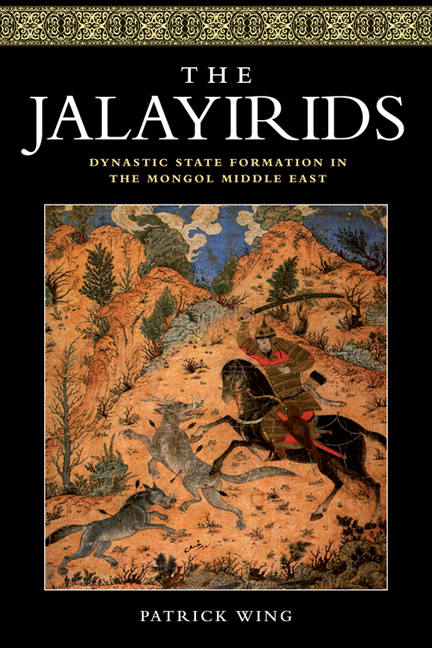Book contents
- Frontmatter
- Contents
- List of Illustrations
- Acknowledgements
- Abbreviations for Primary and Secondary Source Texts
- 1 Introduction and Sources for the History of the Jalayirids
- 2 Tribes and the Chinggisid Empire
- 3 The Jalayirs and the Early Ilkhanate
- 4 From Tribal Amirs to Royal In-laws
- 5 Crisis and Transition (1335–56)
- 6 Shaykh Uvays and the Jalayirid Dynasty
- 7 Dynastic Ideology during the Reign of Shaykh Uvays
- 8 Challenges to the Jalayirid Order
- 9 Conclusions and the Legacy of the Jalayirids
- Maps and Genealogical Chart
- Bibliography
- Index
4 - From Tribal Amirs to Royal In-laws
- Frontmatter
- Contents
- List of Illustrations
- Acknowledgements
- Abbreviations for Primary and Secondary Source Texts
- 1 Introduction and Sources for the History of the Jalayirids
- 2 Tribes and the Chinggisid Empire
- 3 The Jalayirs and the Early Ilkhanate
- 4 From Tribal Amirs to Royal In-laws
- 5 Crisis and Transition (1335–56)
- 6 Shaykh Uvays and the Jalayirid Dynasty
- 7 Dynastic Ideology during the Reign of Shaykh Uvays
- 8 Challenges to the Jalayirid Order
- 9 Conclusions and the Legacy of the Jalayirids
- Maps and Genealogical Chart
- Bibliography
- Index
Summary
In the preceding chapter, an attempt was made to trace the ways in which several Jalayir tribal families participated in the formation of the Ilkhanate and subsequent political events up until approximately the year 1300 ce. Most branches of the Jalayir tribe, whose members had attained prominent positions in the political hierarchy, had been eliminated by the end of the seventh/thirteenth century. These included the family of the vizier Būqā, as well as a number of Jalayir amirs who had led revolts in Anatolia against Ghazan Khan in the first years after his accession in 694/1295. By the beginning of the eighth/fourteenth century, only the Ilgayid branch of the Jalayir retained a strong position in the Ilkhanate. During the reigns of the last three Ilkhan rulers, the descendants of Īlgā would ensure their influence in the post-Ilkhanid period through their status as royal in-laws. By marrying into the Ilkhanid royal family, the Ilgayids not only achieved a proximity to the channels of political power, but also established an important aspect of their legitimising ideology which would be developed during the reign of the Jalayirid sultan Shakh Uvays (r. 757/1356–776/1374).
The purpose of this chapter is to examine the relationship between the Ilgayid Jalayirs and the Ilkhanid dynasty during the last forty years of effective Hülegüid rule (694/1295–736/1335), and to analyse the factors which enabled the Jalayirid amir Shaykh Ḥasan to establish a personal base of political power after this period, and lay the groundwork for the establishment of an independent Jalayirid sultanate. These factors include the Jalayirs’ role as royal in-laws (gūrgān, güregen) at a time when attempts were made to limit the influence of the amirs and centralise authority in the Ilkhanate; the position of Shaykh Ḥasan Jalayir as military governor in Anatolia; and the establishment of Shaykh Ḥasan's control of Arab Iraq and that region's Oyrat tribal military elite.
One of the most significant aspects of the reign of Ghazan Khan (694/1295–703/1304) was his programme of religious and economic reforms.
- Type
- Chapter
- Information
- The JalayiridsDynastic State Formation in the Mongol Middle East, pp. 63 - 73Publisher: Edinburgh University PressPrint publication year: 2016



